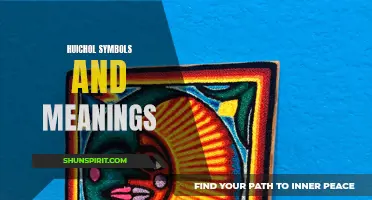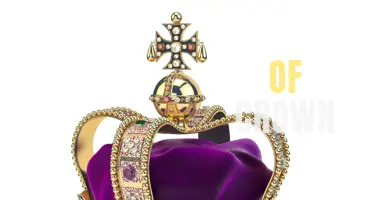
Have you ever wondered about the symbols that represent eternity? These timeless and captivating symbols have been used by civilizations across the world to convey the concept of eternity and everlasting life. From the Celtic Knot to the Ouroboros, these symbols hold profound meanings and are steeped in rich history and mythology. Join me on a journey through the fascinating world of symbols that embody the eternal and discover the secrets they hold.
What You'll Learn
- What are some symbols that represent eternity in various cultures and religions?
- How have the symbols of eternity evolved and changed throughout history?
- What is the significance of these symbols in different belief systems?
- Are there any commonalities among symbols of eternity across different cultures?
- Can symbols of eternity be found in contemporary art and design?

What are some symbols that represent eternity in various cultures and religions?
Symbols of eternity can be found in various cultures and religions throughout history. These symbols carry deep spiritual meanings and represent the concept of everlasting life or infinite time. Let's explore some of the most prominent symbols of eternity from different cultures and religions:
- Ouroboros (Ancient Egypt and Greece): The Ouroboros is a serpent or dragon eating its own tail, forming a circle. It symbolizes the cycle of life, death, and rebirth, and the eternal continuity of nature and the universe. In ancient Egyptian and Greek civilizations, it represented the immortal nature of the pharaohs and the eternal cosmos.
- Mobius Strip (Mathematics and Symbolism): The Mobius Strip is a surface with only one side and one edge. It represents the concept of infinity and oneness. It symbolizes the eternal connection between the past, present, and future, and the continuity of life's cycles. In some spiritual traditions, it also represents unity and the interdependence of all things.
- Yin and Yang (Taoism): The Yin and Yang symbol is an ancient Chinese concept representing the duality of nature and existence. The symbol consists of two halves, one black (yin) and one white (yang), intertwined in a circle. It represents the balance and harmony of opposite forces, such as light and darkness, good and evil, and life and death. It illustrates the eternal interplay and interdependence of these opposing forces.
- Ankh (Ancient Egypt): The Ankh is an ancient Egyptian hieroglyphic symbol resembling a cross with a loop at the top. It symbolizes eternal life and immortality. The loop at the top represents the sun, while the vertical line represents the path of life. It is often held by gods and pharaohs as a symbol of their divine power and everlasting existence.
- Torus (Sacred Geometry): The Torus is a three-dimensional shape resembling a donut. It symbolizes infinity, abundance, and the eternal flow of energy. It is found in various spiritual traditions around the world and is associated with the concept of eternal creation and regeneration.
- Infinity Symbol (∞): The infinity symbol is a mathematical representation of infinity. It is often used as a symbol of eternity and limitless possibilities. It signifies the infinite nature of time, space, and love.
- Mandala (Buddhism and Hinduism): Mandala is a circular pattern of geometric shapes representing wholeness and the universe. It symbolizes the eternal nature of existence and the unity of all things. Mandalas are used in meditation and spiritual practices to attain a state of transcendence and connect with the eternal divine.
These symbols of eternity hold great significance and remind us of the timeless and boundless nature of existence. They offer a sense of solace, hope, and connection to the eternal mysteries of life, death, and the infinite beyond.
Unveiling the Enigmatic Symbols and Deep Meanings Behind Vampires
You may want to see also

How have the symbols of eternity evolved and changed throughout history?
Symbols of eternity have held a significant place in human culture and belief systems throughout history. These symbols, often representing the concept of infinite time or eternal life, have evolved and changed over time, reflecting the cultural, religious, and philosophical beliefs of different societies.
One of the earliest symbols of eternity can be traced back to ancient Egypt. The ancient Egyptians believed in the afterlife and the concept of eternal life. They used the image of a snake or serpent biting its own tail to represent eternity. This symbol, known as the ouroboros, is found in many ancient Egyptian artifacts and is believed to depict the cyclical nature of life and death.
In ancient Greece, the symbol of eternity underwent a transformation and took the form of the Greek letter "alpha" (Α) and "omega" (Ω), which are the first and last letters of the Greek alphabet. This symbol, known as the alpha and omega, was used in early Christian art and literature to represent the eternal nature of God.
During the Middle Ages, symbols of eternity often took on a religious connotation. The most well-known symbol of eternity during this period was the infinity symbol (∞). This symbol, which resembles a sideways figure-eight, represented the infinite nature of God's love and the immortality of the soul.
In the Renaissance period, there was a revival of interest in ancient Greek and Roman culture, leading to a resurgence in the use of ancient symbols. The snake biting its own tail, the ouroboros, made a comeback during this time and became associated with alchemy and the search for eternal life.
In more recent times, symbols of eternity have taken on different forms to reflect the changing beliefs and values of society. For example, the yin and yang symbol from Chinese philosophy, which represents the balance between opposing forces, has been interpreted as a symbol of eternity and the interconnectedness of all things.
Additionally, the concept of eternity has been explored through mathematical symbols such as the infinity symbol (∞) and the sideways figure-eight (∞), which represent an endless loop or cycle. These mathematical symbols have been used in various fields, including physics, mathematics, and engineering, to represent concepts such as infinity, limitless potential, and eternal recurrence.
Overall, symbols of eternity have evolved and changed throughout history, reflecting the beliefs and values of different cultures and societies. Whether it be the ancient Egyptian ouroboros, the Greek alpha and omega, or the modern mathematical infinity symbol, these symbols continue to be used to convey the timeless concept of eternity.
Decoding the Symbolic Language of Life: Unveiling the Meaning Behind Ancient Symbols
You may want to see also

What is the significance of these symbols in different belief systems?
Symbols are powerful tools used to represent complex ideas and concepts in a visual form. They have been used for centuries across different belief systems and cultures to communicate beliefs, values, and traditions. These symbols hold significant meaning and often serve as a means of reverence, inspiration, and guidance for followers.
In various belief systems, symbols are representative of deities, divine forces, sacred places, or philosophical concepts. The interpretation and significance of these symbols can vary from one belief system to another. Here, we will explore some commonly recognized symbols in different belief systems and their meanings.
Cross:
The cross is perhaps one of the most recognizable symbols in Christianity. It is associated with the crucifixion and resurrection of Jesus Christ. The vertical line of the cross represents the divine and the horizontal line represents the Earthly realm. It symbolizes salvation, sacrifice, love, and triumph over death.
Om/Aum:
Om, or Aum, is a sacred symbol in Hinduism, Buddhism, and Jainism. It represents the primordial sound that created the universe. The symbol is composed of three curves, a semicircle, and a dot. Each element signifies different aspects such as creation, sustaining, and transformation. Chanting Om is believed to connect individuals with the divine and promote spiritual growth.
Star and Crescent:
The star and crescent symbol is commonly associated with Islam. The crescent moon represents the lunar calendar and is a symbol of the Islamic month of Ramadan. The star is often associated with the Prophet Muhammad and symbolizes divine guidance and enlightenment.
Yin and Yang:
Yin and Yang are principles in Chinese philosophy that represent the duality and interconnectedness of all things. The concept shows the interplay between opposing forces such as light and dark, male and female, and good and evil. The symbol consists of two teardrop-shaped halves, one white and one black, with a dot of the opposite color in each half, symbolizing unity and balance.
Star of David:
The Star of David, also known as the Shield of David, is a symbol associated with Judaism. It consists of two intersecting triangles, one pointing up and the other down, representing the harmonious relationship between God and humanity. It is also a representation of the six points on the star representing different aspects of Jewish identity: God, Torah, Israel, the Jewish people, Jerusalem, and the Messianic era.
These symbols are just a few examples of the vast array of symbols used in different belief systems. They hold deep meaning and often serve as a visual reminder of the core beliefs and values of the respective faiths. Recognizing and understanding the significance of these symbols can foster inclusiveness and appreciation for the diversity of beliefs and cultures around the world.
Decoding the Map Symbols in Life360: Understanding the Meaning Behind Every Icon
You may want to see also

Are there any commonalities among symbols of eternity across different cultures?
Symbols of eternity have been used in various cultures throughout history, and while the specific symbol may differ, there are often commonalities in their meanings and representations. These symbols are often associated with ideas of infinite time, continuity, and the cyclical nature of life.
One common symbol of eternity that can be found across many cultures is the ouroboros. The ouroboros is a circular serpent or dragon eating its own tail, creating a never-ending loop. This symbolizes the eternal cycle of birth, death, and rebirth. It represents the idea that life is a constant cycle and that everything is interconnected.
Another common symbol is the infinity symbol (∞). This symbol, which resembles a horizontal figure-eight, is often associated with eternal love and infinity. It represents a never-ending loop or continuum. The infinity symbol can be found in various cultures and is often used to express the concept of eternity in a simple and visually recognizable way.
In ancient Egyptian culture, the symbol of the ankh, which resembles a cross with a loop at the top, is often associated with eternity and the cycle of life. It represents the union of male and female energies and is considered a symbol of life and immortality. The loop at the top of the ankh symbolizes eternal life and the continuation of the soul beyond death.
The Celtic knot is another symbol that often represents eternity. These interwoven patterns are commonly found in Celtic artwork and symbolize the interconnectedness of all things. The continuous looping and interlocking design represents the cyclical nature of life and the eternal bond between people and nature.
In Hindu culture, the symbol of Aum (or Om) is associated with eternity and the divine. This sacred symbol represents the sound of the universe, encompassing all existence. It symbolizes the eternal nature of the cosmic order and the eternal cycle of creation, preservation, and dissolution.
While these symbols may vary in their specific design and representation, the underlying concept of eternity remains consistent across cultures. They all embody the idea of infinite time, continuity, and the cyclical nature of life. These symbols serve as a reminder that life is not linear but rather a constant cycle, and that everything is interconnected in an eternal dance of existence.
Exploring the Profound Meaning of Chakra Symbols in Spiritual Practice
You may want to see also

Can symbols of eternity be found in contemporary art and design?
Symbols of eternity have always held a special place in human cultures throughout history. From the ancient Egyptian symbol of the ouroboros, a serpent swallowing its own tail, to the Celtic triskelion and the Chinese yin and yang, these symbols have represented the infinite cycle of existence and the eternal nature of the universe.
But can symbols of eternity be found in contemporary art and design? The answer is a resounding yes. In fact, many artists and designers today are incorporating these symbols into their work to explore concepts of time, eternity, and the cyclical nature of life.
One example of contemporary art that utilizes symbols of eternity is the work of artist Olafur Eliasson. Known for his immersive installations, Eliasson often incorporates elements of light and water to create a sense of infinity. In his 2003 installation titled "The Weather Project," he used a giant, circular-shaped sun made of 200 yellow mono-frequency lamps to create an otherworldly atmosphere. Visitors to the installation were able to bask in the warm glow of the sun, feeling as though they were a part of something eternal and timeless.
In the world of design, symbols of eternity can also be found in various forms. For instance, many jewelry designers create pieces with infinity symbols, such as necklaces and bracelets with the symbol formed by intertwining or looping lines. These pieces serve as reminders of the infinite and eternal nature of love, friendship, and connection.
Similarly, in graphic design, the use of the Möbius strip is a popular way to represent eternity. The Möbius strip is a surface with only one side and one edge, symbolizing the idea of infinity and endlessness. It has been used in logos, packaging design, and even architecture to convey a sense of timelessness and everlasting quality.
Moreover, symbols of eternity are not limited to visual arts. They can also be found in music, literature, and even tattoos. For example, many songwriters and composers use musical motifs that repeat endlessly, creating a sense of eternal rhythm and harmony. Similarly, writers often incorporate symbols of eternity, such as the ouroboros, into their stories to convey themes of eternal recurrence or the cyclical nature of life. And for those seeking a permanent symbol of eternity, getting a tattoo of an infinity symbol or a recurring pattern is a popular choice.
In conclusion, symbols of eternity continue to be a powerful and influential presence in contemporary art and design. Artists and designers use these symbols to explore concepts of time, eternity, and the cyclical nature of life. Whether it's through immersive installations, jewelry design, graphic design, music, literature, or tattoos, symbols of eternity serve as powerful reminders of the infinite and timeless nature of the world we live in.
The Deeper Meaning Behind Drawing Symbols in the Sand
You may want to see also
Frequently asked questions
One symbol that represents eternity is the infinity symbol (∞). This simple and sleek design signifies endlessness and continuity. It has been used in various cultures and religions throughout history to represent eternal love, life, and the infinite nature of the universe.
In the spiritual realm, the infinity symbol is often associated with divine energy and the eternal nature of the soul. It represents the belief in an everlasting existence beyond the physical realm and serves as a reminder of our connection to the divine and the infinite possibilities that life holds.
The infinity symbol itself is typically depicted in a solid black or dark color, representing the timeless and boundless nature of eternity. However, it can also be seen in other hues, such as gold, silver, or white, depending on individual interpretations and personal preferences.
Yes, the infinity symbol can be combined with other symbols to create a more personalized and meaningful representation of eternity. For example, it is often incorporated with a heart symbol to represent everlasting love or with a cross to symbolize eternal spirituality and faith.
While the infinity symbol is the most well-known symbol for eternity, various other symbols have also been associated with eternal themes. These include the ouroboros, a circular symbol depicting a serpent or dragon eating its own tail, symbolizing perpetual renewal and the infinite cycles of life and death. Additionally, the Sanskrit symbol for "Aum" or "Om" is considered a sacred representation of the eternal and timeless nature of the universe in Hinduism and Buddhism.







